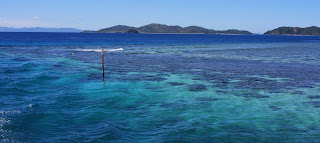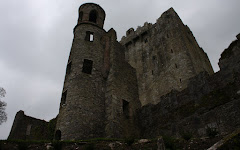
• If every single island in the Fiji archipelago was counted, the number would be in the thousands. Of Fiji’s 322 “counted” islands, 105-110 are inhabited (depending on one’s source of information). In fact, Fiji has more land and people than the rest of Polynesia combined.
• Most of Fiji’s islands are of volcanic origin. Fringing reefs line most coastlines, and the Fiji archipelago includes thirty-three barrier reefs, a staggering amount for any one country. Actually, more than a quarter of the South Pacific’s coral reefs lie in Fijian waters, and the Great Sea Reef is the fourth largest in the world.
• Abel Tasman (Jalayne, et al, remember when we sea-kayaked in Abel Tasman National Park on New Zealand’s South Island?!), the first European explorer to reach Fiji—in 1643, by the way—never actually went ashore. Captain Cook sighted Fiji in 1774, even anchored, but also never went ashore. In 1789, after evading canoes-full of practicing cannibals—thanks to adrenaline-charged rowing by his loyal crew of supporters, a sudden squall, and an unexpected gap in the Great Sea Reef—Captain Bligh, of Mutiny on the Bounty infamy, provided the first accurate picture of Fiji to the Europeans. Although perhaps unwilling explorers who never actually landed either, Bligh and his men ended up rowing through the center of Fiji, between the two main islands, on their escape route to Timor. Bligh, as was his nature, made careful observations, ones ultimately shared with other European sailors/explorers.
• The Moon Handbook, Fiji reports that early Fijians “were extremely hospitable to any strangers they did not wish to eat.” Still, when a cannibalistic tradition is informed by the prevailing belief that shipwrecked persons have been cursed and abandoned by the gods, most voyagers who wrecked on Fijian shores—native or otherwise—were generally killed and eaten.
• The natives’ fierce and warlike reputation and propensity for cannibalism, in addition to the early explorers’ emphasis on the perilous nature of Fiji’s multiple reefs, caused most sea travelers to shun the area for a chunk of time. Fiji became notoriously known as the “Cannibal Isles.”
• Polynesians arrived in Fiji around 1500 B.C. and the Melanesians around 500 B.C. Indigenous Fijians are the resulting mingling of these two groups. Beginning in 1879, the British brought indentured Indian servants to Fiji to work in the sugar industry. According to their contract, the servants could return to India after ten years. More than half of those who immigrated to Fiji stayed in Fiji. By the time the practice ended in 1916, 63,000 Indians lived in Fiji.
• Native Fijians are mostly Christians—Methodists (78%) and Catholics (8.5%) comprising the two largest Christian denominations.** Even still, about 35% of the entire population of Fiji is Hindu or Muslim due to the large Indo-Fijian population; only about 2% have converted to Christianity over the years. Local Chinese also practice Buddhism. In Nadi, Beth and I saw the largest Hindu Temple in the South Pacific, Sri Siva Subrahmaniya Swami Temple*, and while on the highway between Nadi and Sigatoka we saw a good sized mosque as well.
• Any one who has known me very long or traveled with me quickly learns I have a strong aversion to snakes—perhaps even a phobia. Consequently, I prefer to have at least some knowledge of the snake conditions for any locale I may inhabit, however briefly. Many people claim there are no poisonous snakes in Fiji, merely indigenous "harmless" snakes in such scarcity they are rarely seen. The introduction of the mongoose in the late 19th century to control rats in the sugar cane plantations on the main islands decimated Fiji’s land-dwelling bird, snake and amphibious populations. Nevertheless, Fiji does have a terrestrial venomous snake, which can come as a bit of a shock to people with a snake mindset similar to mine who hear many a Fijian claim that Fiji is snake-free apart from the pacific boa—as in one of those very rarely seen snakes mentioned earlier. Even more appalling to those sharing this snake antipathy is the added detail that this snake is an elapid, one belonging to the same family as the Indian cobra and the Australian taipan. Still, no real trepidation need prevail as at last count less than twenty of these venomous snakes were located in all of Fiji. (With overwhelming gratitude, I kept this snake report at the forefront of my consciousness during one grand Fijian adventure to be reported in a future post!)
• Fijian waters do house sea snakes. (I saw nary a one…thankfully!) One of my sources provided this information, which I did find interesting:
“There are lots of long wiggly things that live in the sea and most of the ones that you will encounter are actually not sea snakes. The sea snake you are most likely to see in Fiji whilst goggling is the Banded/Yellow Lipped/Colubrine Sea Krait (Laticauda colubrina). These are fairly small, being about half to one and a half meters in length and generally not much thicker than a man's thumb. They are however the sixth most venomous snake in the world (behind Australia's Taipans, King Browns and Tiger snakes), with fangs able to deliver a mixture of powerful neurotoxins and myotoxins which affect the nervous system and skeletal muscles. The chance of being bitten by one of these sea kraits is minimal, though. They are amphibious reptiles which differ only from land-based snakes in having specially adapted paddle-like tails for swimming and diving. They must surface to breath every fifteen minutes or so and will be observed snooping and poking around the shallow reef edge in search of eels to eat. They search for food using their forked tongue as a sensor and have little or no interest in you. They pose no threat unless agitated or provoked.”
*Sri Siva Subrahmaniya Swami Temple in Nadi. A man at the gate stopped Beth and me from entering the grounds, informing us that he needed to be sure that we met the criteria for entrance. (See last photo below.) After surveying our attire and realizing we met the necessary clothes criteria, he asked if we were vegetarian. We answered no. He asked if we had eaten meat in the last 24 hours, and we confessed that we had done so. "Don't eat any more meat," he said, "and come back tomorrow. Then you can come in." Hence, we photographed the temple from outside the compound; we already knew that we would not be returning on the morrow!



**There is an LDS Temple in Suva, the capital of Fiji. (We didn't have enough time to include Suva in our itinerary.) One article that I read about Fiji mentioned that Mormons made up about 1% of Fiji's Christian population. On-line I did look up Mormon meeting houses and times for services in the Nadi/Sigatoka area, and there was a ward (Nadi) plus two branches listed.







































